There’s no denying just how much our lives have changed since Covid. The coronavirus pandemic has transformed how we live, work and play. The business world has adopted hybrid working practices, and many of us are enjoying working near-permanently from home, without plans to return to the daily grind of fighting traffic.
Our newly hybrid world and the massive adoption of LinkedIn presents a greater opportunity to cast your net wider and network online. Why? Because that’s where we are all spending the majority of our time.
Without peers sitting behind us, less rushing from here to there for meetings and reduced travel, decision-makers are more accessible and more open to communication. Periods of social isolation has been tough and we are all yearning for connection and collaboration.
How can you improve your online presence to bolster your networking efforts? By giving your LinkedIn profile an overhaul!
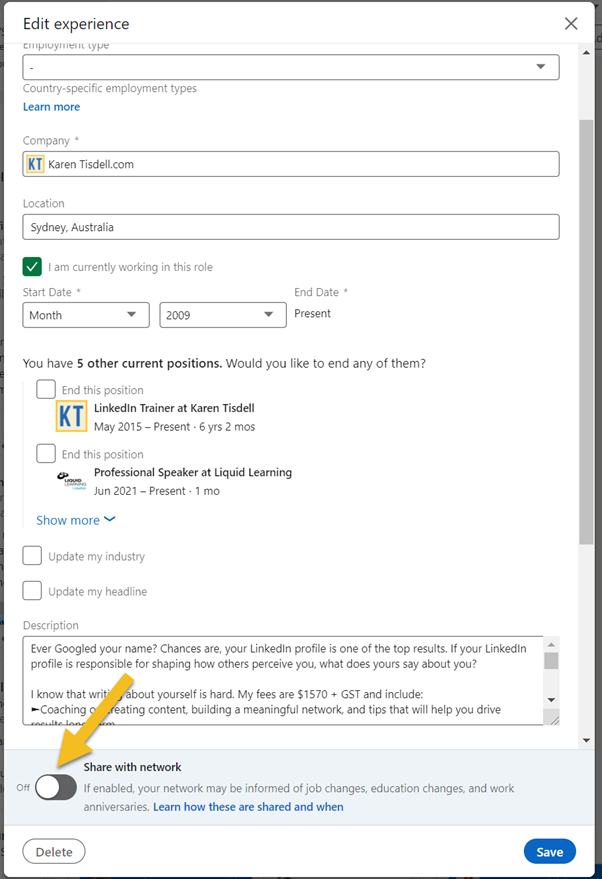
Before we start though, click on the edit pencil in whatever section you are working on, scroll to the bottom and ensure that the slide bar is set to ‘Off’.
Check this setting every time you save changes, noting that notifications are very good announcements if you have changed roles, been promoted, recently completed an MBA or some other significant studies.
(1) Headline
Aside from your name and picture, your Professional Headline is the only part of your profile that is instantly visible in LinkedIn search results. It also follows you everywhere on LinkedIn, when people find you in searches, when you comment, in companies and on the top of your posts. This is why you have to use these 220 characters to grab people’s interest, so they’ll want to click on your profile.
Your headline should sum up who you are and the problems you solve, but there’s no need for it to be bland. Most users (approximately 70%) simply have their name and company here, as this is what LinkedIn defaults to. However, you’ll stand out from the crowd by being a bit more creative with your headline.
Firstly, it’s important to think about keywords. Just like Google, LinkedIn uses keywords to determine how highly your profile will rank in search results, so you need to be thinking about the keywords that are most relevant to what you do. Try to put yourself in the mindset of your ideal client or prospective employer – what search terms would they use if they were searching for someone to solve their pain?
Once you’ve established the most relevant keywords to use, you can start thinking of more creative ways to put them together, such as giving yourself a catchy slogan. Think of yourself as a brand and consider how do you want to sell yourself?
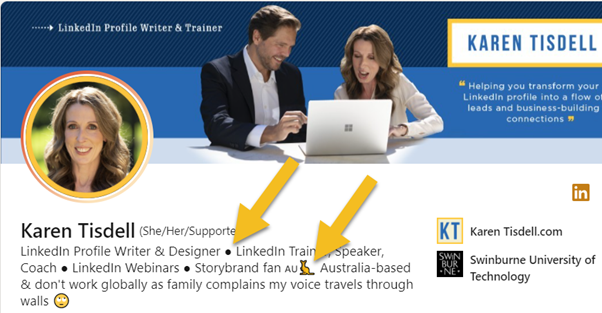
As LinkedIn is highly visual with almost everyone having a background banner these days, you should consider making your profile more graphically appealing and memorable by separating your keywords with emojis rather than just writing them as a list.
Pipes are okay – but having been abandoned by LinkedIn and other sites a few years ago, they may look old school…
(2) Background banner
Your background banner has a lot of prominence on your profile so if you have not yet replaced the LinkedIn default blue background, you’re not going to stand out and you will not get noticed.
The image you choose should depend on what you want your LinkedIn profile to achieve. If you want your employees to increase the company’s brand reach, offer each employee the option to upload an image that has a company logo – as all the best companies do.

If your employer has not yet provided a background banner, the image you use should reflect your value proposition. If you’re promoting services or products, it’s a good idea to reduce barriers by including contact details in the image – if this doesn’t make it too cluttered. Tag lines or a description of what the company does is also helpful in converting your audience to buying customers.
Do not have a beach scene or something that infers you wish to be on holiday! LinkedIn is a professional platform and accordingly, your banner needs to further your professional goals.
(3) About section
Your About section really needs to start as strong as possible, as only the first 270 characters are visible on desktop before the person viewing your profile has to click on “See More”. Of course people only click when they are interested, so you must ensure your first 270 characters form a hook, and make a real impact. A great way to do this is to start with a question, or an intriguing statement.
If your initial sentence or two are interesting enough, you should be expecting users to click on “See More”. This is why it’s important to have something extra to offer those who do. You should then explain not just what you do, but why you do it.
With a total of 2600 characters (approx 360 words), it’s vital that your About section contains information about the value you can offer clients or prospective employers, that your competition can’t. State clearly how you can make their lives easier, for example, by explaining how you solve problems using your particular skills and experience.
Employers are always looking to recruit new employees whose values align with those of their business, and similarly clients want to know that you are genuinely committed to solving their problems. It’s important to let readers know your why, what makes you tick, and what made you choose your particular field – because we all connect more easily with people who care about the same things as us.
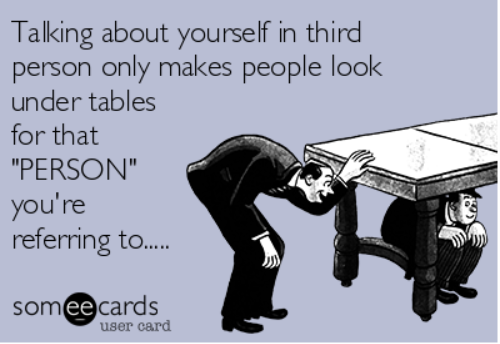
Crucially, be authentic and reflect who you are in a realistic way, rather than simply aiming to please the people you’re hoping to attract. By being yourself and highlighting your skills and interests to your best advantage – you will attract people you truly want to work with.
Never use third-person perspective (referring to yourself by name), and instead use I and You to give readers the sensation that you are speaking to them directly. It will appear aloof and distant to talk about yourself as if you are not yourself. If you are not convinced that you should use I and you then check out this 1.22 minute video on how our language needs to match current trends in leadership style…
(4) Skills endorsements and recommendations
Your Skills section is all about proving that you have the know-how to do the work you do. It also appears to feed the ranking when someone searches for your skills, so as much as it pains me to say this, more is currently better… Just be careful you don’t dilute your number of endorsements by mentioning similar skills twice (Eg Management and Leadership).
Keeping in mind that only three of your skills are immediately visible on your profile, it’s important to make sure those skills are the ones that best align with your goals and describe strengths that are most relevant to the job/client/industry you are pursing. You can reorder your skills by unpinning, clicking and dragging on the four lines on the right of each skill as pictured and shown in the video here and pictured below.
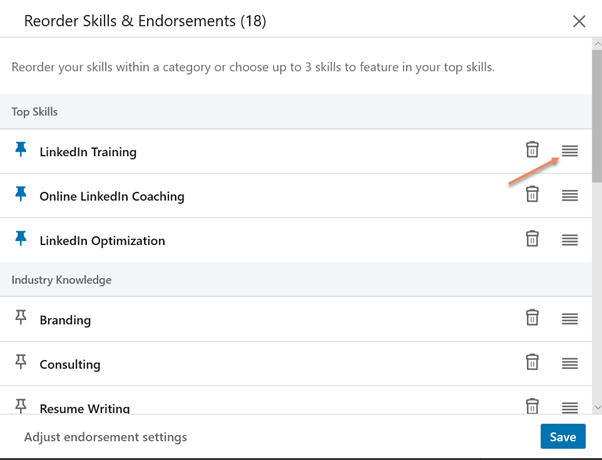
You must have your skills endorsed by others if you want people to feel they can trust you. Try pushing yourself out of your comfort zone and casually ask for endorsements every time somebody praises your work. You don’t have to be pushy, as people are often grateful to have a way to help – if you approach them in a friendly and low-pressure way.
Similarly, don’t be shy. If you are looking for a new role, and you know your peers are too, consider asking (gently) if you can write each other a recommendation, being specific in what you would like mentioned.
Personally, I find that giving recommendations feels good. If you are a leader in an organisation, consider normalising both recommendations and endorsements by monthly reflecting on the performance of individual team members and endorsing their skills, writing recommendations for specific projects and accomplishments. Why should you do this? Because these days, few people care about acknowledgements unless the whole world sees it… Take comfort that you can always delete recommendations at a later date if the employee does something terrible.
Concerned that your employees will leave if you endorse them? That is like the cartoon below…
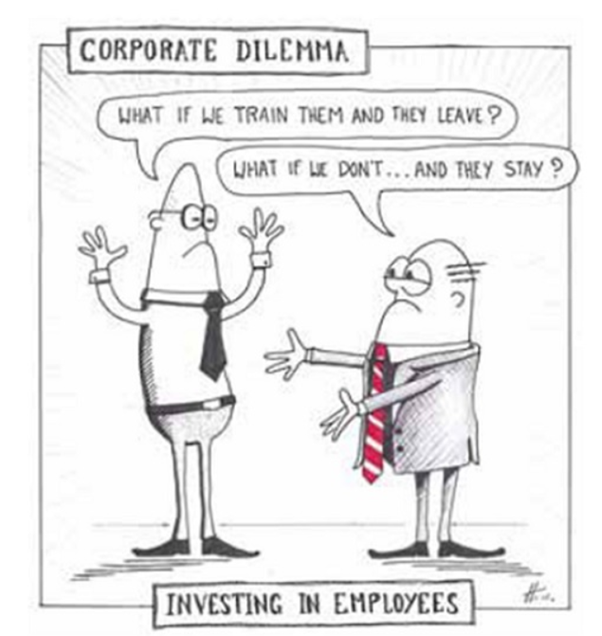
Recommendations and skills endorsements demonstrate trust and foster employee loyalty and commitment in a way that few reward and recognition programs can achieve. All at no cost. Plus, a higher number of endorsements and recommendations will lift clients perception of the quality and talents of your team members – growing sales conversions.
(5) Experience section
Don’t ever cut and paste your resume to your LinkedIn profile, instead stop and consider again your LinkedIn objective. If your goal is to attract more clients, it will look weird for your profile to read as a resume – and certainly few clients will want to hear about your successes in sales. Instead clients want to hear that you are skilled in solving their problems.
If you are sprucing up your LinkedIn profile to attract a new employer, or influence how your peers perceive you, cutting and pasting your resume into your LinkedIn profile gives the reader no reason to contact you with questions. Instead keep your statements short, strongly action-orientated and focussed on the difference you deliver.

Keep in mind that you can use symbols instead of bullets in your all-important experience section of your profile, as demonstrated in my friend Robert’s, who in having permitted me to use him as an example years ago of how a profile could be arranged, was subsequently approached about a new role because of his profile on LinkedIn. Robert was not, and most certainly is NOT looking for a job – but he kindly permits me to still use him as an example.
(6) Adding media
A frequently underutilised area of LinkedIn is Media, and Featured. A great profile is far more sophisticated than a résumé on steroids — it is your digital reputation, validating who you are and the expertise you hold.
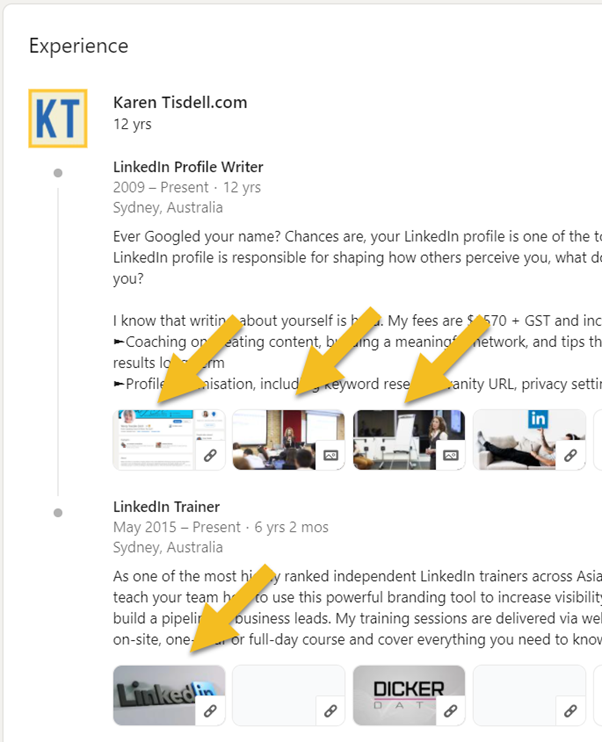
However we often connect with people who simply don’t know all that we have accomplished, causing the undervaluing of our skills, talents and services.
You can build on how others think of you without constant bragging and hero statements by adding media. Sitting in the Experience section of your profile and relevant to each job, these are evidence of previous successes, awards and presentations in the form of external news articles, photos, website links, videos and SlideShare presentations.
To ensure these show to those that are just skimming your profile (and who do not scroll down to the experience section), it is crucial that you use the Featured tool to highlight key messages and achievements.
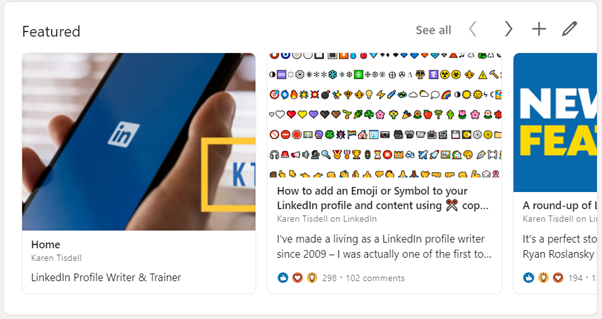
As you can see pictured here you can highlight articles, landing pages or company websites in the Featured section.
These additions are powerful evidence that you are a specialist and a subject matter expert!
Noting that only a little over two are immediately visible on desktop and only a little over one on mobile, just ensure that you change the order so the most relevant is first.
(7) Customising your URL
Lastly, if you want to make an impact – you will need to be memorable and easy to find. A custom URL makes you look like you take care of the online image you’re presenting – something that is even more critical in this Covid-impacted time.
If it seems like too much effort don’t be fooled – the more memorable you are, the more job offers, clients and opportunities you can expect to get!
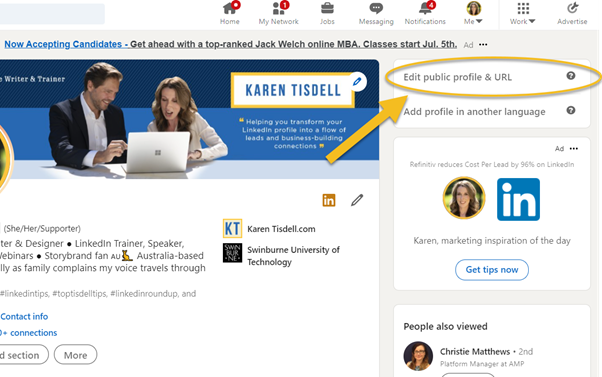
Remember, everyone under 30 has grown up digitally literate and millennials don’t even have to think about presenting themselves as tech-savvy – they do it automatically. No matter what age or level, you need to keep up to look relevant.
Don’t worry if someone else on LinkedIn has the same name as you – you can use your URL as an opportunity to stand out even further in your field, by adding your job title or industry sector after your name, for example Joe-Bloggs-Accountant or Joe-Bloggs-Supply-Chain.
While this modification will look especially great on your resume, if you use business cards don’t forget to have your URL printed underneath your phone and email address because we all need to remember that LinkedIn is where your customers are increasingly searching for the services and technical expertise they need!
To point out the obvious: While LinkedIn is a personal branding tool where you control what is said about you, in this new world where we are unable to meet face to face, it is crucially one of the few places where you can generate job and business leads, represent your company, or find and reach out to old contacts to explore new opportunities.
As LinkedIn is a social selling and recruitment tool that works on the basis of relationships, when you craft your LinkedIn profile, it is important to think about who you are and how you want to be perceived.
Be authentic and let your character show through because we need to see who you really are to connect, communicate and collaborate…
